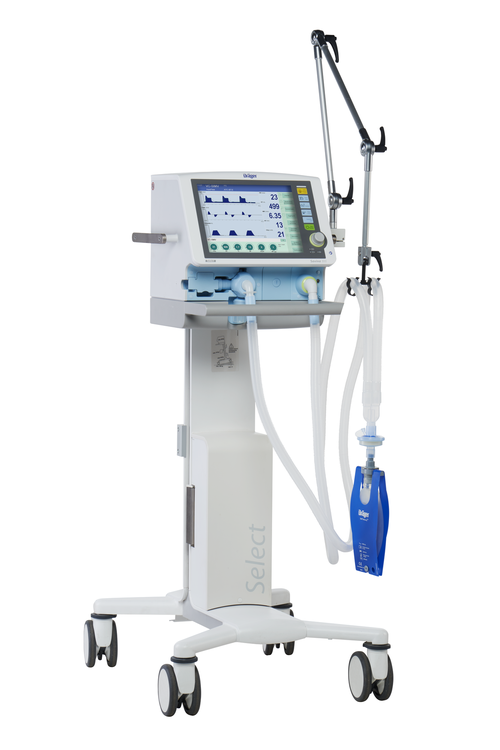Drager Savina 300 Select
MIDDLE EAST
Certified Refurbished Medical Equipment
The Drager Savina 300 Select combines the independence and power
of a turbine- powered ventilation system with cutting edge ventilation modes.
For the first time Drager offers a ventilator with oxygen therapy
and Automatic Tube Compensation which where just for intensive care in the past.
The Savia 300 Select operates independently for a centra power
and gas supply making more flexible in a hospital setting. The ventilator is suitable
for invasive and non-invasive therapy for acute and chronic care of patient
from neonates to adults.
The Drager Savina 300 select was designer to meet the ventilation needs
for the most critically ill patients and flexible to be used anywhere in the hospital.
The 300 Select uses ambient air to filter through the ventilation system.
The ventilator system keeps the reparatory gas at a permanently high flow delivery
of up to 250 l/min. The ventilator can react quickly to pressure fluctuations
and compensate for possible leakages in the case of patients ventilated
with a mask.
The large color touch screen design and the intuitive operating system
make operation simple
Sophisticated ventilation modes for critically ill patients (e.g. PC-APRV, VC-MMV)
Automatic Tube Compensation ATC® reduces the work of breathing for intubated patients with spontaneous breathing
Stress-free spontaneous breathing with excellent trigger response time due to the turbine
Free breathing with AutoFlow® in volume constant ventilation at a minimum pressure level
Non-invasive ventilation (NIV) available in all modes with a very quick response times to patient efforts
Extended graphic capabilities with loops, trends and logbook
Pediatric ventilation with enhanced trigger detection
Savina 300 Select Specifications
Dimensions (without trolley)
Height: 15.08in (383 mm)
Width: 18.11in (460 mm)
Depth: 14.33 in (364 mm)
Weight: 57.3lbs (26 kg)
Diagonal Screen size: 12in TFT color touch screen
Ventilation Modes
VC-CMV / VC-AC
VC-SIMV
VC-MIMV
PC-APRV
PC-BIPAP1 / PC-SIMV+
PC-AC
SPN-CPAP
Enhancements
AutoFlow – Automatic adaption of the inspiratory flow in volume oriented ventilation modes
NIV – Non Invasive Ventilation with optimized alarm systems and automatic leakage compensation
Capnography – Mainstream CO2 measurement
MonitoringPlus – Loops, Trends, user Logbook
LPO – Low Pressure Oxygen, independent oxygen supply, e.g. with an O2 concentrator
Nurse call – Connection for transmitting alarm signals to a central, alarm system
Automatic tube compensation ATC – Automatic tube compensation regulates the airway pressure to the tracheal level
O2 Therapy – Continuous flow is applied via an oxygen mask, a hood or nasal cannula for patients with independent breathing
General
Patient type: Adult, pediatric
Respiratory rate: 2/min to 80/min
Inspiration time: 0.2 to 10 s
Tidal volume: 0.05 to 2.0 L, BTPS2) with option PediatricPlus 0.02 to 2.0 L
Inspiratory pressure:: 1 to 99 mbar (or hPa or cmH2O)
PEEP/interm. PEEP 0 to 50 mbar (or hPa or cmH2O)
Pressure support/ΔPsupp: 0 to 50 mbar (or hPa or cmH2O) (relative to PEEP)
Flow acceleration: 5 to 200 mbar/s (or hPa/s or cmH2O/s)
O2-concentration: 21 to 100 Vol. %
Trigger sensitivity (Flow trigger): 1 to 15 L/min
Inspiratory termination criterion: 5 to 75 % PIF (peak inspiratory flow)
PC-APRV (optional):
Inspiratory time Thigh 0.2 to 22.0 s
Expiratory time Tlow 0.1 to 22.0 s
Inspiratory pressure Phigh 1 to 95 mbar (or hPA or cmH2O)
Expiratory pressure Plow 0 to 50 mbar (or hPA or cmH2O)
Displayed Measured Values
Airway pressure measurements Max. airway pressure, plateau pressure, mean airway pressure, PEEP 0 to 99 mbar (or hPa or cmH2O)
Minute volume (MV): Total MV, spontaneous MV 0 to 99 L/min, BTPS
Tidal volume: Inspiratory VT, expiratory VTe, VTspon 0 to 3999 mL, BTPS
Total respiratory rate: Total and spontaneous respiratory rate, 0 to 150/min
Inspiratory O2-concentration: 21 to 100 % Vol.
End-tidal CO2 concentration: EtCO2 0 to 100 mmHg (or 0 to 13.2 Vol% or 0 to 13.3 kPa)
Breathing gas temperature: 18 to 48 °C (64.4 to 118.4 °F)
Curve displays: Paw(t), Flow (t), Tidal volume (t), CO2 (t)
Ventilation ratio (I:E): 1:150 to 150:1
Compliance C: 0.5 to 200 mL/mbar (or mL/hPa or mL/cmH2O)
Resistance R: 3 to 300 mbar/L/s (or hPa/L/s or cmH2O/L/s)
Leakage minute volume MVleak: 0 to 100 %
Rapid shallow breathing RSB: 0 to 9999 (1/min/L)
Special Maneuvers (optional):
Intrinsic PEEP PEEPi 0 to 100 mbar (or hPa or cmH2O)
Exp. Hold
Alarms
Airway pressures: high / low
Expiratory minute volume: high / low
Tidal volume: high / low
Apnea-alarm time: 15 to 60 sec
Spontaneous breathing frequency: high
Inspiratory O2-concentration: high / low
Inspiratory breathing gas temperature: high
EtCO2: high / low
Performance Data
Maximum (continuous) inspiratory flow: 250 L/min
Valve response time T0…90: ≤ 5 ms
Control principle: time-cycled, volume-controlled, pressure limited
Safety valve opening pressure: 120 mbar (or hPa or cmH2O)
Emergency valve: automatically enables spontaneous breathing with filtered ambient air if air and O2 supply should fail.
Automatic gas switch-over function if O2 supply fails
Output for pneumatic medication nebulizer: synchronized with inspiration
Leak compensation:
optimized patient-ventilator synchrony adjusts the flow trigger and the inspiratory termination criteria for leaks.
tube application: up to 10L/min
NIV VC-modes: up to 25 L/min
NIV PC-modes: unlimited
Operating Data
Mains power connection: 100 V to 240 V, 50/60 Hz
Current consumption: max. 1.3 A at 240 V, max. 3.4 A at 100 V
Battery: internal typically 45 min (optional extension up to 5 h)
Turbine exchange interval: 8 years, with no limit in operating hours during this interval
Digital Machine Outputs
Digital output and input via an RS 232 C interface
Dräger MEDIBUS and MEDIBUS.X
Gas Supply
Air Turbine technology
O2 gas supply 3 bar (43.5 psi) – 10 % up to 6 bar (87 psi)

